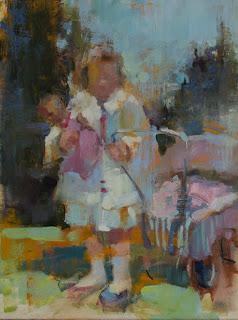
Baby Doll

detail
Students of painting who come to me for workshops or classes frequently tell me that there are 2 things that they want to learn: looseness and creative color.Colour is a lifetime's occupation and I learn more about it every day in the studio, but looseness is actually pretty straightforward. Looseness happens at the edges of a shape, where it interacts with another shape. Becoming a looser painter simply takes a bit of courage and a lot of unlearning.
We start our artistic lives by being praised for colouring within the lines in our colouring books. It's a mark of hand-eye control and our parents and teachers applaud it. But that can be the start to a lifetime of drawing and respecting outlines, and it can be a hard habit to break.
Working from photos only reinforces this dependance on the outline, especially with the crisp quality that modern cameras can achieve. If you look at a digital photo, you'll see that everything, no matter how far apart in distance, can seem in focus. So the foreground flowers are as crisp as the distant foothills, and even the mountains. And that way of seeing is only possible through the lens; our eyes can't do it.
Cameras also have one lens - a single point of view - which flattens the world. Cover one of your eyes and you'll see how flat everything becomes. The photographic world is not our binocular world. Add to that the fact that we, the viewers, are never perfectly still: we blink, breathe, shift our weight and viewpoint slightly and constantly, and you'll see that the camera view isn't our experience at all. We live in a world without outlines; one in which the edge of objects is ambiguous and shifting, and in which objects have 3 dimensions.
So, how do you loosen up? For a time, work from life, and really analyze what you're seeing. An apple on a table can teach lessons that no amount of photo reference work can. Examine it's edges and you'll discover that some are lost against a similar value in the background, or crisp where there's a big value change.

Picnic detail

Picnic
Look at the apple set up out of the corner of your eye instead of directly. That's how we see the world: it's a series of relationships between patches of color and value.
Talk to yourself in abstract rather than object terms: Not: I'm painting an apple on a plate on a table, but: I'm painting this big patch of red which is the same value as the blue disk under it, so it will have ambiguous, lost edge potential.
It's all about training and trusting your eyes. You don't see the world like a camera does, and, with some thoughtful looking and painting, you can train your eyes to see and your brain to understand what you're seeing. The lessons that life painting teach you can be applied to the photo reference later on, but I'd advise spending a few months (or years), just working from the real world.
I also said you need courage to be a looser painter, and that's because once you see the amount of lost and soft edges that the real world contains, you have to paint it that way. Lose the notion of a world made of precisely outlined things, and paint a world in which outlines are slippery suggestions of location that are impossible to firmly pin down. Get those kindergarten teachers out of your head, and know that colouring outside the lines - and knowing that there aren't any lines - is a valid way to work.
Happy painting!

